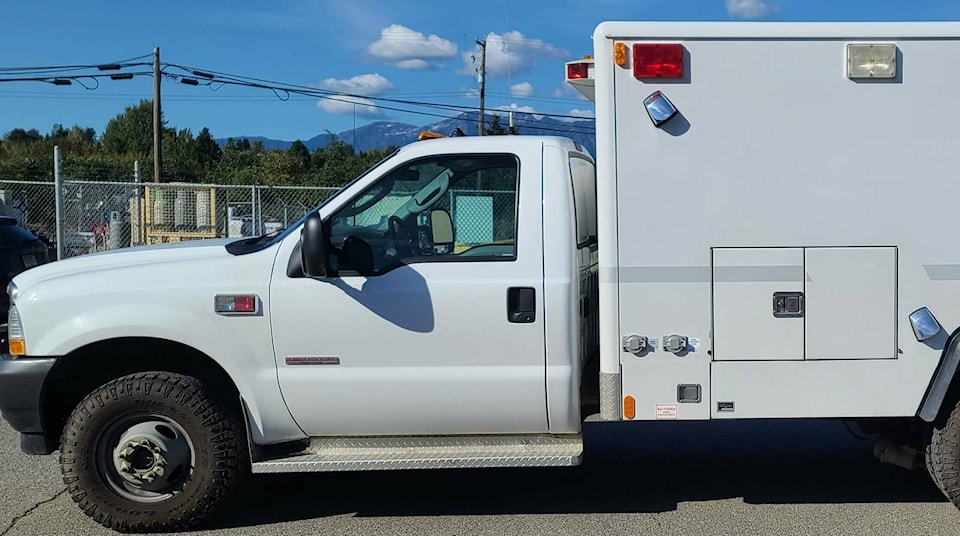Efforts are underway to establish a complete ambulance service covering the Nass Valley.
To be based in Laxgalts’ap (Greenville), one of the four villages in the valley and roughly at its centre, the service will feature a reconditioned ambulance and four paramedics.
“They provided the ambulance station with living accommodations for a 24-hour a day operation when ready,” explained Leonard Hanson, the unit chief of Nisga’a Emergency Medical Transportation, an arm of the Nisga’a Valley Health Authority, of the assistance coming from the Laxgalts’ap village government.
It’s a complex arrangement involving not just the valley’s health authority, but BC Emergency Health Services which provided the ambulance now being reconditioned, the four villages in the valley, the Nisga’a Lisims Government and the First Nations Health Authority which has replaced the federal government when it comes to overall health services in B.C. for Indigenous people.
But at the heart of it is close cooperation between the new service and BC Emergency Health Services, the agency which runs the provincial ambulance fleet.
“We are in the process of meeting regulatory compliance and certification to operate as an ambulance in the province of B.C.,” Hanson said of reconditioning the donated ambulance and training the paramedics.
That’ll result in Nisga’a Emergency Medical Transportation being recognized as a patient transport service and with the capability to respond to medical emergencies.
And as with the provincial ambulance service’s community paramedic offshoot, Hanson said paramedics also hope to visit people in their homes.
“We also will be helping where we can with the communities in mainly home care programs, getting to know elders and performing medical assessments in their homes,” he said.
All this is not to say there has been no ambulance service in the valley over the years.
BC Emergency Health Services does have existing agreements with the valley’s four villages, Gingolx, Laxgalts’ap, Gitlaxt’aamiks and Gitwinksihlkw, so that first responders from those villages can be dispatched depending upon what’s required.
And it provided the Gitwinksihlkw Fire Department with a decommissioned ambulance in 2020 to complement its first responder capability.
Gitwinksihlkw Fire Department chief Simon Calder describes his department’s first responder and transport capability as an integral part of the department and of the community.
Of the department’s 25 members, all volunteers, eight are certified as emergency medical responders and have been trained by Calder.
“I’ve been doing this since I was 12 and I’m 39 now,” said Calder of the deep-rooted Gitwinksihlkw service.
Gitwinksihlkw’s first responders will often meet provincial ambulances travelling north up Hwy 113 from Terrace halfway for patient transfers, an arrangement which saves each ambulance from the time consumed in making a complete return trip.
“We work closely with Terrace, we know them all,” said Calder of the relationship between the Terrace ambulance station and his own department.
The Gitwinksihlkw department also has a Jaws of Life and responds to road accidents in addition to other emergencies.
“That’s our goal, to help people in need of medical assistance,” said Calder.
If not called out within the valley, Gitwinksihlkw’s first responders will be dispatched by the provincial system, he added.
“We’ve even gone up to Stewart, we can get there a lot faster than an ambulance from Terrace,” Calder said.
On average, Calder said the department responds to an annual average of upwards of 400 calls of all types per year.
“We have two life support machines that can provide respiratory assistance,” he said of the capability of his department.
Calder said he’s looking forward to working with the new valley-wide service envisioned through the Nisga’a Nisga’a Emergency Medical Transportation.
It’s a sentiment also expressed by Hanson, its unit chief.
“We will be a transport ambulance with the capability to respond to medical emergencies but will be leaving most emergency calls to the first responders that have been doing this service for our communities for a long time now,” he said.
